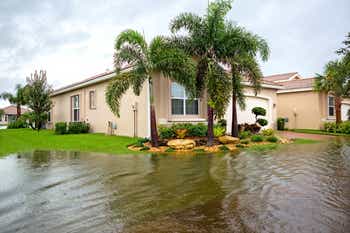Floods are one of nature’s most unpredictable and destructive forces, often striking with little warning. But with a bit of planning and know-how, you can protect yourself, your loved ones, and your property from the worst effects of flooding. In this guide, we’ll walk you through steps necessary to prepare for a flood, from creating a plan to understanding your insurance options.
Create a Flood Preparedness Plan
Floods can happen quickly, so it’s a good idea to have a solid flood preparation plan. Let’s break down some key steps to ensure you’re ready when the water starts to rise.
Develop an Emergency Kit
An emergency kit is your go-to resource when a flood is on the horizon. It should include essential items such as:
- Non-perishable food (three-day supply)
- Bottled water (three-day supply)
- Medications (seven-day supply)
- Extra clothing
- Flashlight
- Batteries
- First-kid kit
- Personal hygiene items
- Multi-purpose tool
- Important documents — e.g., birth certificates, homeowners insurance, etc.
Keep this kit in a place that’s easy to grab, and make sure everyone in your household knows where it is.
Build a Family Evacuation Plan
When a flood strikes, you may need to leave your home quickly. That’s where a family evacuation plan comes into play. Start by identifying safe routes out of your home and neighborhood. Pick a couple of meeting points — one near your home and another further away in case you need to evacuate the area entirely. Communication is key during an emergency, so make sure everyone knows how to stay in touch. You may also want to use a family member or friend outside the flood zone as a central point of contact.
Secure Your Home
Taking steps to protect your property can help minimize flood damage. If you live in a flood-prone area, sandbags can be a great first line of defense to keep water at bay. You might also consider elevating appliances and utilities like your furnace, water heater, and electrical panels to prevent water damage. Don’t forget about your important documents and valuables — store them in waterproof containers or move them to higher ground.
Stay Informed and Ready
Follow these tips, and you’ll be better prepared to protect yourself and your loved ones during and after a flood.
Monitor Weather Alerts
Being aware of flood watches, warnings, and advisories will give you the time to act. Make a habit of regularly checking reliable sources for real-time information, such as the National Weather Service, local news stations, or weather apps. Many areas also offer emergency alert systems that can send notifications directly to your phone, so sign up for these services to get immediate updates.
What to Do After a Flood: Safety Tips
Knowing how to stay safe during a flood doesn’t end when the waters subside. Before you return home, make sure it’s safe to do so. Watch out for downed power lines, contaminated water, and structural damage. If your home has been flooded, don’t wade through standing water because it can be hazardous due to unseen debris or electrical currents. It’s also important to wear protective gear like gloves and boots to avoid injuries or infections. Once you’re back, thoroughly inspect your home for damage, and ventilate and dry out affected areas as quickly as possible to prevent mold.
Flood Insurance Considerations
Let’s explore what you need to know to protect your home and belongings.
Purchase Flood Insurance
Standard homeowners insurance typically doesn’t cover flood damage, but flood insurance is available through the National Flood Insurance Program (NFIP). This insurance is optional for most homeowners; however, if you have a mortgage from a federally regulated or insured lender and your home or business is in a high-risk area, you’re legally required to buy flood insurance. Even if you don’t live in a high-risk area, flood insurance may still be a sound purchase.
File a Claim Immediately
If your home is affected by a flood, you need to file a claim as soon as possible. Start by taking photos or videos of everything affected, including your home’s exterior and interior, as well as any personal belongings that were damaged. You should also keep an inventory of your property and note the condition before the flood and the extent of the damage afterward. Once you do that, contact your insurance provider and be prepared to provide all the necessary information. The insurance company will then send an adjuster to survey the damage.
Conclusion
Floods can wreak havoc on your property, and clean-up can be a lot of work, but with the right preparation, you and your family can weather the storm.
While Mercury doesn’t offer flood insurance, we do provide cheap homeowners insurance that helps protect your home and belongings from various risks, including fire, theft, wind damage, and liability claims. Our customizable policies ensure that you’re covered in the ways that matter most, giving you peace of mind no matter what life throws your way.


